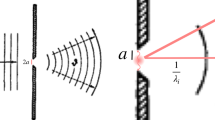Abstract
I attempt to develop further the statistical interpretation of quantum mechanics proposed by Einstein and developed by Popper, Ballentine, etc. Two ideas are proposed in the present paper. One is to interpret momentum as a property of an ensemble of similarly prepared systems which is not satisfied by any one member of the ensemble of systems. Momentum is regarded as a statistical parameter like temperature in statistical mechanics. The other is the holistic assumption that a probability distribution is determined as a whole as most likely to be realized. This is the same as the chief assumption in statistical mechanics, and maximum likelihood in classical statistics. These ideas enable us to understand statistically (1) the formalism of quantum mechanics, (2) Heisenberg's uncertainty relations, and (3) the origin of quantum equations. They also explain violation of Bell's inequality and the interference of probabilities.
Similar content being viewed by others
REFERENCES
A. Einstein, B. Podolsky, and N. Rosen, Phys. Rev. 47, 777 (1935).
K. Popper, Quantum Theory and the Schism in Physics (Routledge, London, 1982).
A. Ballentine, Rev. Mod. Phys. 42, 358 (1970).
M. Jammer, The philosophy of Quantum Mechanics, the Interpretation of Quantum Mechanics in Historical Perspective (Wiley, New York, 1974).
The italic part is the statement by A. Einstein, in Albert Einstein: Philosopher-Scientist, P. A. Schilpp, ed. (Open Court, La Salle, Illinois, 1949), p. 81.
L. Cohen, Found. Phys. 18, 983 (1988).
B. R. Frieden, Phys. Rev. A 41, 4265 (1990).
B. R. Frieden, Found. Phys. 21, 757 (1991).
B. R. Frieden, Physica A 198, 262 (1993).
W. K. Wootters, Phys. Rev. D 23, 357 (1981).
M. Ravicule, M. Casas, and A. Plastino, Phys. Rev. A 55, 1695 (1997).
E. Madelung, Z. Phys. 40, 322 (1926).
E. Nelson, Phys. Rev. 150, 1079 (1966).
R. E. Collins, Found. Phys. Lett. 7, 39 (1994).
R. E. Collins, Found. Phys. 26, 1469 (1996).
L. Rosenfeld, in Questions of Irreversibility and Ergodicity: Ergodic Theories, P. Caldirola, ed. (Zanichelli, 1962).
B. R. Frieden, and B. H. Soffer, Phys. Rev. E 52, 2274 (1995).
G. V. Vstovsky, Phys. Rev. E 51, 975 (1995).
J. S. Bell, Physics 1, 195 (1964).
J. F. Clauser, and M. A. Horne, Phys. Rev. D 10, 526 (1979).
L. D. Landau, and E. M. Lifshitz, Statistical Physics (Pergamon, New York, 1962), § 110‐127.
Rights and permissions
About this article
Cite this article
Shirai, H. Reinterpretation of Quantum Mechanics Based on the Statistical Interpretation. Foundations of Physics 28, 1633–1662 (1998). https://doi.org/10.1023/A:1018841625620
Issue Date:
DOI: https://doi.org/10.1023/A:1018841625620




